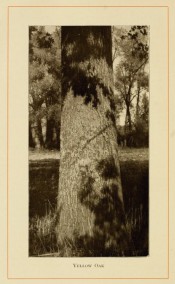Quercus velutina Lam.
Fully-hardy, fast-growing, spreading, deciduous tree with ridged, almost black bark, elliptic, deeply-lobed leaves, to 25cm long, turning red-brown in autumn, and spherical acorns. To 30m. [RHSE, Hortus, Hilliers’].
Horticultural & Botanical History
‘Those who call this tree black oak have in mind the bark which is usually quite dark, though all members of this species do not present the same appearance in that respect. Some trunks are gray, and in color do not greatly differ from white oaks, but would hardly be mistaken for them. Tanbark oak, a name occasionally given to this tree, is not applied in the region where chestnut oak grows, because it is much inferior to chestnut oak as tanning material. It is not only poorer in tannin, but the coloring matter associated with the inner bark is troublesome to the tanner who is compelled to remove it or neutralize it unless he wants his leather given a yellow tone. Dyer’s oak is a name which refers to the value of the bark for coloring purposes. The botanical name velutina refers to the velvety texture of the inner bark.
This oak is one of the easiest to identify. The inner layer of the bark is yellow. The point of a knife easily reaches it; cutting through a deep crack in the bark, and no mistake is possible, for no other oak has the yellow layer of bark. The tree may be identified by leaves, flowers, and fruit, but the process is not always easy, for other members of the black oak group bear more or less resemblance to this one.
The yellow oak’s range extends over nearly or quite a million square miles. It exceeds the limits of most oaks in its geographical extension. It endures severe winters and hot summers. The northern limit of its range lies in Maine; it grows westward across southern Canada to Minnesota; it extends two hundred miles west of the Mississippi into eastern Nebraska and Kansas, and follows that meridian south into Texas. It reaches the Gulf of Mexico east of the Mississippi, and is found in many localities in all the southern states, and along the foothills of the Appalachian ranges. It attains its largest size in the lower Ohio valley.’ [Gibson – American Forest Trees p.271/1913].
Introduced to Europe in 1800. [Hilliers’]. The inner bark is a bright yellow from which is extracted the dye quercitron. [RHSD].
History at Camden Park
Listed in the 1845, 1850 and 1857 catalogues as ‘Quercus discolor’ [T.799/1845] and in the 1845, 1850 and 1857 catalogues as ‘Quercus tinctoria - Dyer’s Oak’ [T.813/1845]. There is little doubt that these are the same species. ‘Quercus tinctoria - Dyer’s Oak’ was probably imported for utility rather than ornament.
Notes
Published Feb 03, 2010 - 03:06 PM | Last updated Feb 03, 2010 - 03:11 PM
| Family | Fagaceae |
|---|---|
| Category | |
| Region of origin | Eastern North America |
| Synonyms |
|
| Common Name | Black oak, Yellow bark oak, Dyer?s oak |
| Name in the Camden Park Record |
Quercus discolor |
| Confidence level | high |


